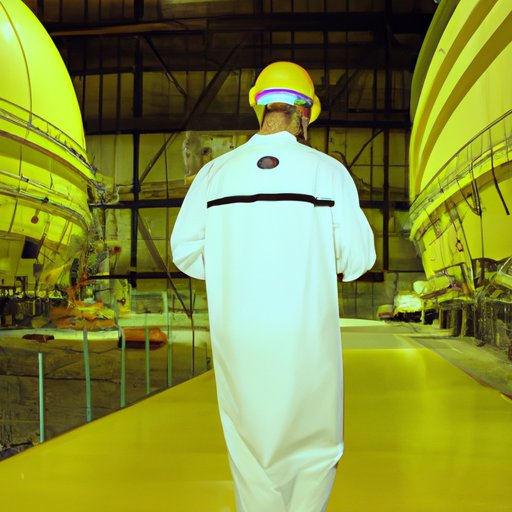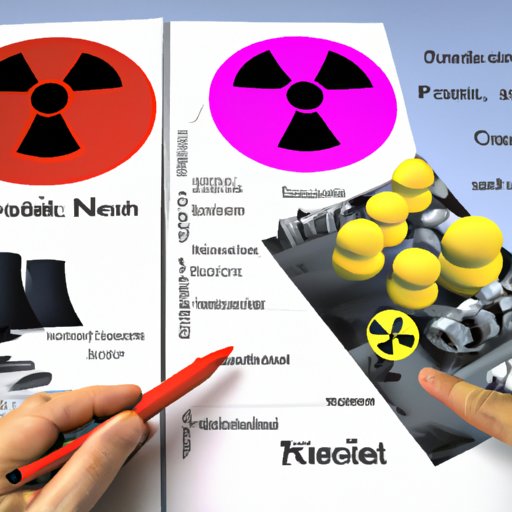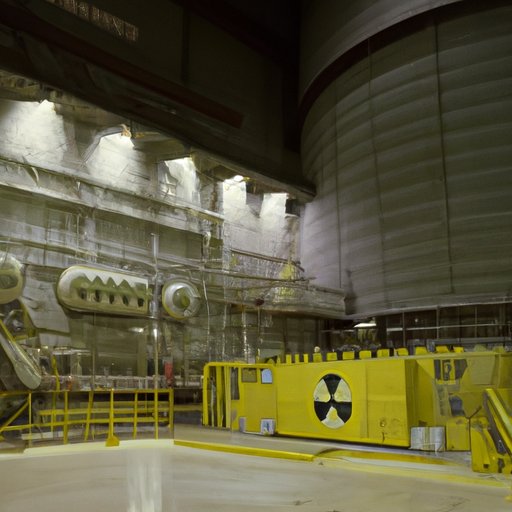Introduction
A nuclear power plant is an electricity-generating facility powered by a nuclear reactor. Nuclear power plants produce energy through a controlled fission reaction of uranium atoms, releasing heat and radiation. This heat is then used to produce steam, which powers a turbine generator to generate electricity.
Nuclear power plants can generate large amounts of electricity in a relatively short amount of time and with minimal emissions, making it a popular source of clean energy. However, there are also many safety concerns surrounding nuclear power, as any mistakes could lead to catastrophic accidents. In this article, we explore how nuclear power plants work, examining their components, process, pros and cons, and safety measures.

Exploring the Different Components of a Nuclear Power Plant
Nuclear power plants consist of several key components that work together to generate electricity. The main components of a nuclear power plant include:
Fuel Sources
At the heart of a nuclear power plant lies the fuel source. Nuclear fuel typically comes in the form of uranium pellets, which are housed in long rods. These rods are placed inside the reactor core, where they undergo a nuclear fission reaction, releasing energy in the form of heat and radiation.
Reactor Core
The reactor core is the central component of a nuclear power plant, where the fission reaction takes place. The reactor core is typically made up of hundreds of rods containing the nuclear fuel. Control rods, which absorb neutrons, are inserted into the core to regulate the rate of the reaction.
Coolant System
The coolant system is responsible for cooling the reactor core and preventing it from overheating. The coolant is typically water or gas, circulated around the core to absorb its heat and transfer it elsewhere. The heated coolant is then used to generate steam, which powers the turbine generator.
Turbine Generator
The turbine generator is responsible for generating electricity. The hot steam produced by the coolant system is passed through the turbine blades, causing them to spin at high speed. This spinning motion is connected to a generator, which produces electricity.

Examining the Pros and Cons of Nuclear Power Generation
Nuclear power has many advantages and disadvantages, which should be weighed carefully when considering whether it is the right choice for a given situation. Here we examine some of the main pros and cons of nuclear power generation.
Advantages
One of the main advantages of nuclear power is that it is a clean energy source. Unlike traditional fossil fuels, nuclear power does not produce harmful emissions such as carbon dioxide, nitrogen oxide, and sulfur dioxide, which are known to contribute to air pollution and climate change. Additionally, nuclear power plants can generate large amounts of electricity in a relatively short amount of time.
Research conducted by the United States Energy Information Administration (EIA) shows that nuclear power plants have higher capacity factors than other types of power plants, meaning they are able to generate more electricity over a given period of time. According to the EIA, the average capacity factor for nuclear power plants in the United States was 92.5% in 2019, compared to only 65.9% for natural gas plants.
Disadvantages
The main disadvantage of nuclear power is the potential for catastrophic accidents. As the radioactive materials used in nuclear power plants are highly dangerous, even small mistakes can lead to serious consequences. For example, the 1986 Chernobyl disaster in Ukraine resulted in the release of massive amounts of radiation into the environment, leading to numerous deaths and long-term health effects.
Additionally, nuclear power plants require a large initial investment, and the cost of decommissioning them is often very high. Nuclear waste must be safely stored for thousands of years before it can be disposed of, meaning that nuclear power plants leave a lasting environmental impact.
A Step-by-Step Guide to Understanding the Nuclear Power Plant Process
The nuclear power plant process consists of three main stages: pre-operation preparation, operation of the plant, and shutdown of the plant. Here we provide a step-by-step guide to understanding each stage of the process.
Pre-Operation Preparation
Before a nuclear power plant can begin operating, it must go through a series of tests and inspections to ensure that all components are working correctly and that all safety regulations are being followed. In this phase, the reactor core is filled with fuel rods, control rods are inserted, and the coolant system is tested. Additionally, the turbine generator is inspected and prepared for operation.
Operation of the Plant
Once the pre-operation preparations are complete, the nuclear power plant can begin operating. In this stage, the reactor core is activated and the fission reaction begins. The heat and radiation released by the reaction is absorbed by the coolant system, which produces steam to power the turbine generator. The generator then produces electricity, which is sent out to the grid.
Shutdown of the Plant
When the nuclear power plant reaches the end of its operational life, it must undergo a shutdown procedure. During this process, the reactor core is gradually cooled down and all the fuel rods are removed. The turbine generator is also shut down, and the plant is decommissioned.
Investigating the Safety Measures in Place at Nuclear Power Plants
Given the potential risks associated with nuclear power generation, safety is of paramount importance at nuclear power plants. Here we examine some of the safety measures that are in place to protect workers and the public.
Regulatory Requirements
All nuclear power plants must comply with strict regulatory requirements set by the government. These regulations cover everything from design and construction to operation and decommissioning. All plants must pass regular inspections to ensure they are meeting these requirements.
Emergency Planning
Nuclear power plants must have emergency plans in place to deal with any potential accidents. These plans outline the steps that must be taken in the event of an emergency, such as evacuating the area and providing medical care for those affected. Additionally, all staff must receive regular training in emergency procedures.
Containment Structures
Nuclear power plants are typically surrounded by thick concrete walls known as containment structures. These structures are designed to contain any radioactive material that might be released in the event of an accident. Additionally, all nuclear power plants must have backup systems in place to ensure that the reactor core can be safely shut down in an emergency.
Conclusion
Nuclear power plants are a reliable and efficient source of clean energy. However, due to the potential risks associated with nuclear power generation, it is important to understand how these plants work and the safety measures that are in place. This article has provided an overview of the components of a nuclear power plant, the process of generating electricity, the pros and cons of nuclear power, and the safety measures that are in place.
(Note: Is this article not meeting your expectations? Do you have knowledge or insights to share? Unlock new opportunities and expand your reach by joining our authors team. Click Registration to join us and share your expertise with our readers.)
